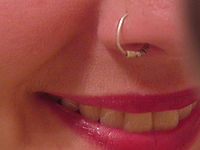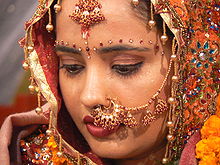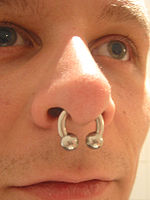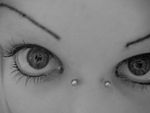- Nose piercing
-
Nose piercing 
Nicknames Nose ring Location Nose (nostril, nasal septum, nose bridge) Jewelry nose stud, nose bone, Circular barbell, curved barbell, captive bead ring Healing 10 to 12 weeks Nose piercing is the piercing of the skin or cartilage which forms any part of the nose, normally for the purpose of wearing jewelry; among the different varieties of nose piercings, the nostril piercing is the most common. Nose piercing is one of the most common varieties of piercing after earlobe piercing.
Contents
Nostril piercing
Nostril piercing is a body piercing practice often associated with India, Nepal and through out South Asia. Nostril piercing is also part of traditional Australian Aboriginal culture (Stirn 2003). Nostril piercing has in recent decades become popular in the industrialized nations, as have other forms of body piercing. Afterwards punks and subsequent youth cultures in the '80s and '90s adopted this sort of piercing. Today, nostril piercing is popular in the United States of America, the UK, Canada, the Caribbean, Australia and Europe, with piercings being performed on either the left or right nostril.
Both men and women have nostril piercings, though they are much more common on women. There are several different types of nostril rings. Among the most popular are the loop, the stud with an L-bar closure, the stud with a ball closure, and the stud with a flat backing.
In India the outside of the left is the preferred position of the piercing as this is supposed to make childbirth easier. This is because Ayurvedic medicine associates this location with the female reproductive organs. In India piercings were regarded as a mark of beauty and social standing as well as a Hindu's honor to Parvati, the goddess of marriage, a practice dating to the 16th century. Nose piercing is still popular in India. They are often part of Indian wedding jewellery. In Maharastra women wear very large nose pieces that often cover the mouth or the side of the face.
It is common for Pashtun and Pahari women to have both nostrils pierced. Many South Indian Tamil also follow this tradition. The tradition follows that the woman has her nose rings to pay for her funeral if she has all the gold taken from her. Nose rings or gold studs cannot be easily removed from the woman. Many women from the Asian subcontinent are cremated with just their nose studs as jewellery is removed before the funeral. Indian widows usually remove their nose studs as a sign of respect. Hindu women also remove their bangles and bindi when widowed.
Nose piercing in society
Although occasionally seen earlier — the French actress Polaire arrived for her 1913 tour of America wearing a seed-pearl ring in her left nostril[1] — it's only been in the last two decades that nose piercing has gained a mainstream popularity in Western culture. Presently, it is the second most-popular body piercing desired by teens and young adults.
A 2007 study[citation needed] by career publisher Vault.com surveyed nearly 500 employees from across the United States and 87 percent believed having piercings or tattoos would not reduce their chance of being hired. Respondents explained, "Regardless of who the real person may be, the stereotypes associated with piercings and tattoos are changing. In general, individuals with tattoos and body piercings are not being looked down upon as did in previous generations;" "I see more and more people with piercings in business and everyday work settings. It's just a different generation," Says another employer.[citation needed]
Another study was held by a group of 20 sociology majors at Columbia University in 2001.[citation needed] They surveyed 100 New Yorkers looking for a job, 50 with nostril/cartilage piercings and 50 with eyebrow/tongue piercings. It was said that the 50 with nostril and cartilage piercings received jobs that those with eyebrow and tongue could not. "Many people are used to the nose piercings, it is seen as a cultural icon in the Indian and African communities," says student J. Sanchez. "Many people with facial piercings are seen as 'rougher' or 'less educated' and these stereotypes are hurting many people looking for work," said professor F. Holloway.[citation needed]
Nose piercing are considered more acceptable than eyebrow or tongue. Eyebrow piercings were created during the 1980s during what most teens considered the punk-rock era and are since associated with emotional behavior and heavy metal music. When nose rings are more seen with Indians, and more professional people such as doctors, teachers, lawyers and many political figures. "I personally do not judge my students or colleagues depending on their facial piercings. I would say 25 percent of the faculty here have nose or cartilage piercings. But there are probably more at NYU or other liberal arts universities," says Holloway.[citation needed]
Septum piercing
Nasal septum piercings are less common than nostril piercings. The nasal septum is the cartilaginous dividing wall between the nostrils. Generally, the cartilage itself is not pierced, but rather the small gap between the cartilage and the bottom of the nose (sometimes called the "sweet spot"), typically at 14ga (1.6mm) although it is often stretched to a larger gauge (size). The nose has many nerves running through it and as a result, nose piercings can be painful, although it varies by individual. This piercing heals within a month and a half to three months also depending on the individual. It should only be stretched by 1mm at a time and it is advised to wait at least a month between stretches. If you go past a certain point, usually about 8mm, the cartilage gets forced towards the top of the nose, which can be uncomfortable.
There are many types of jewelry generally worn in a septum piercing including: Captive bead rings (CBRs), rings that close with a bead held in the center by the tension of the ring, circular barbells (as shown in the picture), a circular bar with a bead that screws on to either end, a "tusk" which is a straight or shaped piece of material which is generally tapered on either end, or pinchers. For large gauge septums many choose to wear plugs, as they do not weigh their noses down, which is helpful in the healing process. This allows for the piercing to not be damaged by the sudden movement of the jewelry.
Bengali women traditionally would wear the 'nathori' as a sign of being a married woman. The nathori would be gold with a tear drop that would move along the ring. This is now declining as many women prefer the nose studs.
Another option is a septum retainer, which is staple shaped. This type of nose piercing is particularly easy to hide when desired, for example to comply with a dress code. A septum retainer makes it possible to turn the jewelry up into the nose, thus concealing it. With black jewellery flipped up into the nostrils, this piercing can be made practically invisible. A circular barbell can also be hidden by pushing it to the back in to your nose , but it may be uncomfortable.
Septum piercing was a popular trend among South Indian dancers (Kuchipudi, Bharatnatyam) and among certain Native American peoples in history; the Shawnee leaders Tecumseh and Tenskwatawa, for example, had such piercings. The septum piercing is popular in rural areas of India, Nepal and Bangladesh. In India it is called the 'Nathori' and popular with the Banjara ethnic groups and Adivasi tribes. Lord Krishna and his consort Radharani are often depicted wearing the 'Nathori' style jewel nose pieces.
Bridge piercing
Bridge piercings are inserted through the small flap of skin at the top of the nose, between the eyes, though never through the bone. Curved barbells and straight barbells are the most commonly used in this piercing, while seamless rings are less common. However, bridge piercings generally have a high rate of rejection and thus are less common than any other nose piercing.
See also
References
- ^ New York Times, September 21, 1913
Stirn, A. (2003). Body Piercing: Medical Consequences and Psychological Motivations. The Lancet 361: 1205-1215.
External links
Septum Piercing Jewellery For Women
Body piercing General piercing topics Contemporary piercing practices · Scalpelling · Stretching · Play piercing · Pocketing · Surface piercing · Ear piercing gunJewelry (materials) Barbell · Claw · Captive bead ring · Flesh tunnel · Plug · Prince's wand · Spiral · Stud · Nose chain · Nipple shieldEar piercings Facial and oral piercings Body piercings Unisex genital or anal piercings Female genital piercings Christina · Clitoris · Clitoral hood · Triangle · Fourchette · Isabella · Labia · Nefertiti · Princess AlbertinaMale genital piercings Ampallang · Apadravya · Hafada · Foreskin · Deep shaft · Dolphin · Dydoe · Frenum (Frenum ladder) · Lorum · Magic cross · Prince Albert · Reverse Prince Albert · TransscrotalCategories:- Facial piercings
- Body piercing jewellery
- 1980s fashion
- 1990s fashion
- 2000s fashion
Wikimedia Foundation. 2010.




